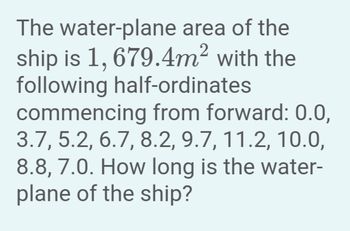
Elements Of Electromagnetics
7th Edition
ISBN: 9780190698614
Author: Sadiku, Matthew N. O.
Publisher: Oxford University Press
expand_more
expand_more
format_list_bulleted
Concept explainers
Question

Transcribed Image Text:The water-plane area of the
ship is 1, 679.4m² with the
following half-ordinates
commencing from forward: 0.0,
3.7, 5.2, 6.7, 8.2, 9.7, 11.2, 10.0,
8.8, 7.0. How long is the water-
plane of the ship?
Expert Solution
This question has been solved!
Explore an expertly crafted, step-by-step solution for a thorough understanding of key concepts.
Step by stepSolved in 2 steps

Knowledge Booster
Learn more about
Need a deep-dive on the concept behind this application? Look no further. Learn more about this topic, mechanical-engineering and related others by exploring similar questions and additional content below.Similar questions
- )The pool shown below has dimensions of 20-ft long (perpendicular to the page), 12-ft wide and water depth of 6-ft. Assume standard values for the water. A B 12 ft 6 ft a) Calculate the water pressure (psig) on the bottom of the pool. b) Calculate the weight (lb) of the water in the pool. Pressure = c) Calculate the resultant force (lb) of the water on wall AB. Weight=arrow_forwardSHOW COMPLETE AND DETAILED SOLUTION. PLEASE WRITE LEGIBLY. GIVEN: SOLUTION:arrow_forwardA rectangular plane has its longer side 30mm long and shorter side 20mm long. The longer side is parallel to VP and is 15mm in front of VP. The rectangular plane has one of its shorter sides on the HP and it is inclined to the HPin such a way that it looks like a square having 20mm long sides when looked from the top. Draw projections of this plane and find its inclination with the HParrow_forward
- Determine the operating flow rate and net head of the pumping system in the pipe network that you have selected based onyour ÖN number and using the curves in the graph. Show the operating point on the graph and write its values (you can draw the graph in excel) ÖN= 5arrow_forwardPlease see attached.arrow_forwardMany aspects of a gymnast's motion can be modeled by representing the gymnast by four segments consisting of arms, torso (including the head), thighs, and lower legs, as in the figure below. Thigh O Arm Leg 60° 60° Torso a b In the figure, (b) shows arrows of lengths r, locating the center of gravity of each segment. Use the data below and the cg coordinate system shown in figure (b) to locate the center of gravity of the gymnast shown in figure (a). Masses for the arms, thighs, and legs include both appendages. (Enter your answers in m, to at least three significant figures.) Segment Mass (kg) Length (m) (m) Arms 6.89 0.548 0.242 Torso 33.6 0.613 0.337 Thighs 14.1 0.376 0.145 Legs 7.50 0.350 0.227 HINT m %D m y cg E Earrow_forward
- Needs Complete typed solution with 100 % accuracy.arrow_forwardNeed help. Please round answers to 3 sig figsarrow_forwardHomework Draw (i) the sectional view from the front and (ii) the view from the left of the sliding support, shown in Fig. below. 2 HOLES, DIA 8 48 48 友229) 32 44 64 20 Fig. 4.13 Sliding supportarrow_forward
- A crate is hung by three ropes attached to a steel ring at A such that the top surface is parallel to the xy plane. Point A is located at a height of h = 83.82 cm above the top of the crate directly over the geometric center of the top surface. Use the given dimensions from the table below to perform the following calculations: a.) Determine the position vector b.) Compute the unit vector ûCA that points from point point A. c.) If rope AB carries a tension force of magnitude F = 674 → N, determine the force vector FT that expresses how this force acts on point A. 2013 Michael Swanbom cc i❀O BY NC SA Express each vector in Cartesian components to three significant figures. b PAD cm cm that describes rope AD ↑Z cm y Values for dimensions on the figure are given in the following table. Note the figure may not be to scale. Be sure to align your cartesian unit vectors with the coordinate axes shown in the figure. Variable Value aarrow_forward" THEOREMS OF PAPUS " Please refer to the answer key (book from Engineering Mechanics by SInger) Please include the analyzation of figure so that i could undestand the steps and solution. Thankyou!arrow_forwardSolve by using dimensional analysis. Calculate the weight in lbf of a 58 lbm object in a place where the acceleration of gravity is 32.09 ft/s2. Final answer in two decimal. Please show your complete solution and write clearly. Thank you.arrow_forward
arrow_back_ios
SEE MORE QUESTIONS
arrow_forward_ios
Recommended textbooks for you
 Elements Of ElectromagneticsMechanical EngineeringISBN:9780190698614Author:Sadiku, Matthew N. O.Publisher:Oxford University Press
Elements Of ElectromagneticsMechanical EngineeringISBN:9780190698614Author:Sadiku, Matthew N. O.Publisher:Oxford University Press Mechanics of Materials (10th Edition)Mechanical EngineeringISBN:9780134319650Author:Russell C. HibbelerPublisher:PEARSON
Mechanics of Materials (10th Edition)Mechanical EngineeringISBN:9780134319650Author:Russell C. HibbelerPublisher:PEARSON Thermodynamics: An Engineering ApproachMechanical EngineeringISBN:9781259822674Author:Yunus A. Cengel Dr., Michael A. BolesPublisher:McGraw-Hill Education
Thermodynamics: An Engineering ApproachMechanical EngineeringISBN:9781259822674Author:Yunus A. Cengel Dr., Michael A. BolesPublisher:McGraw-Hill Education Control Systems EngineeringMechanical EngineeringISBN:9781118170519Author:Norman S. NisePublisher:WILEY
Control Systems EngineeringMechanical EngineeringISBN:9781118170519Author:Norman S. NisePublisher:WILEY Mechanics of Materials (MindTap Course List)Mechanical EngineeringISBN:9781337093347Author:Barry J. Goodno, James M. GerePublisher:Cengage Learning
Mechanics of Materials (MindTap Course List)Mechanical EngineeringISBN:9781337093347Author:Barry J. Goodno, James M. GerePublisher:Cengage Learning Engineering Mechanics: StaticsMechanical EngineeringISBN:9781118807330Author:James L. Meriam, L. G. Kraige, J. N. BoltonPublisher:WILEY
Engineering Mechanics: StaticsMechanical EngineeringISBN:9781118807330Author:James L. Meriam, L. G. Kraige, J. N. BoltonPublisher:WILEY

Elements Of Electromagnetics
Mechanical Engineering
ISBN:9780190698614
Author:Sadiku, Matthew N. O.
Publisher:Oxford University Press

Mechanics of Materials (10th Edition)
Mechanical Engineering
ISBN:9780134319650
Author:Russell C. Hibbeler
Publisher:PEARSON

Thermodynamics: An Engineering Approach
Mechanical Engineering
ISBN:9781259822674
Author:Yunus A. Cengel Dr., Michael A. Boles
Publisher:McGraw-Hill Education

Control Systems Engineering
Mechanical Engineering
ISBN:9781118170519
Author:Norman S. Nise
Publisher:WILEY

Mechanics of Materials (MindTap Course List)
Mechanical Engineering
ISBN:9781337093347
Author:Barry J. Goodno, James M. Gere
Publisher:Cengage Learning

Engineering Mechanics: Statics
Mechanical Engineering
ISBN:9781118807330
Author:James L. Meriam, L. G. Kraige, J. N. Bolton
Publisher:WILEY